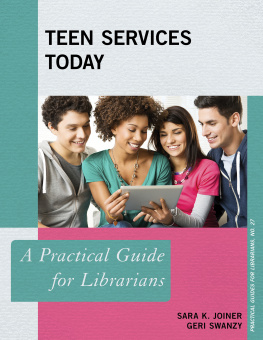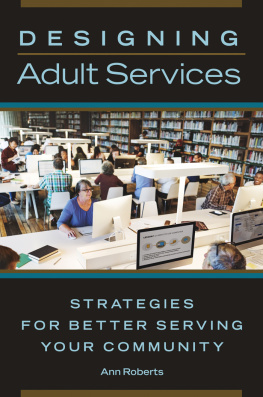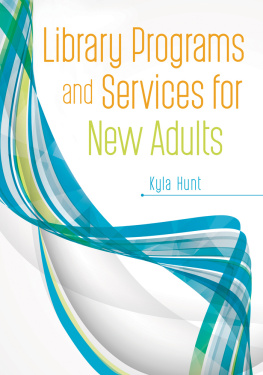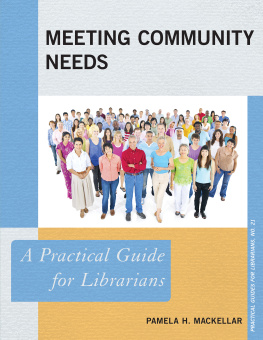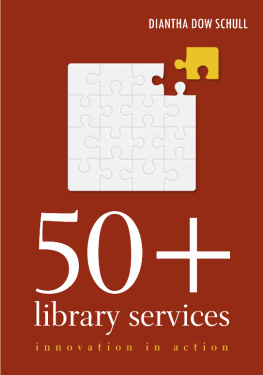PUBLIC LIBRARY PROGRAMS AND SERVICES FOR MIDLIFE AND BEYOND
Expanding Opportunities for a Growing Population

Rene K. Bennett-Kapusniak

Copyright 2018 by Rene K. Bennett-Kapusniak
All rights reserved. No part of this publication may be reproduced, stored in a retrieval system, or transmitted, in any form or by any means, electronic, mechanical, photocopying, recording, or otherwise, except for the inclusion of brief quotations in a review, without prior permission in writing from the publisher.
Library of Congress Cataloging in Publication Control Number: 2018005116
ISBN: 978-1-4408-5778-2 (paperback)
978-1-4408-5779-9 (e-book)
22 21 20 19 18 1 2 3 4 5
This book is also available as an e-book.
Libraries Unlimited
An Imprint of ABC-CLIO, LLC
ABC-CLIO, LLC
130 Cremona Drive, P.O. Box 1911
Santa Barbara, California 93116-1911
www.abc-clio.com
This book is printed on acid-free paper 
Manufactured in the United States of America
This book is for my family and for all those who dedicate their selfless gifts to serve others.
Contents
Preface
Midlife and older adults or adults 50 + are a large cohort that is steadily increasing in population. Different organizations define and categorize adults 50 + . However, a uniform definition has been difficult because this age group has varying characteristics. Many adults are active and healthy, whereas others experience physical and cognitive changes as a natural process of aging. Some continue to work into their 70s and 80s, and others retire, travel, or volunteer in their communities. Technology usage among midlife and older adults is also increasing. However, there are still some adults 50 + who have had little or no training with computerized systems. These are just some of the diverse characteristics we need to consider when planning and implementing public library adult services and programs that will engage the aging community.
As public librarians, we are always striving for valuable resources and ideas to help us better serve all our community members. With this in mind, this book explores a random sample of American public libraries to see how they are serving, promoting, and engaging adults 50 + in their communities. Further contributions are gathered from our public library peers in the field, providing practical examples and views from librarians and directors to assist in the development and expansion of adult 50 + programs and services, allowing us to see how different ideas have worked within different types of communities.
Outreach and the importance of community collaborations are explored, detailing how utilizing partners within the community provides benefits and valuable resources. This includes peer examples to give ideas and suggestions in establishing our own partnerships. Marketing and funding strategies with peer examples are also included, providing resources and tips for working with adults 50 + . Formal and informal lifelong learning opportunities are discussed, detailing the benefits and impact our peers have had with their library communities. Technology is part of our daily lives, with more information coming online every day. The importance of digital literacy and the role public libraries play for their community members, including overcoming barriers to access to assist in digital inclusion and to support all community members to participate fully in our technological society, are included with examples from the library field.
This book was developed to create more awareness and interest in the underserved adult 50 + populations within our public library system. The intent is to provide a manual about midlife and older adults to enrich understanding of the aging population. Plus, the book provides a valuable resource for adult 50 + public library programming and services, giving us the tools to create and expand our services and programs for adults 50 + in our own library communities.
Acknowledgments
First and foremost, I wish to thank Jessica Gribble and the editors of Libraries Unlimited for asking me to create this timely and valuable work on adults 50 + . Your valuable advice and suggestions helped to improve the quality of my work.
In addition, I wish to thank all public librarians for your dedication to your professions and for always striving to find the perfect program or service for your community patrons. I also want to sincerely thank all the contributors to this text: Alexandra Annen, Adrienne Doman Calkins, Mariel Carter, Marian Christmon, Brianne Columbo, Richard Conroy, Marie Corbitt, Leslie DeLooze, Debra DeJonker-Berry, Elizabeth Eisen, Debbi Gallucci, Kathleen Goodson, Kristi Haman, Kathleen Handy, Lynn Harthorne, Dan Hubbs, Chris Jackson, Heather Johnson, Ryan Johnson, Buff Kahn, Lucine Kauffman, Tamar Kreke, Kelly Martin Laney, Meryle A. Leonard, Beth Neunaber, Lisa Picker, Lisa Prizio, Matthew Riley, Chad Robinson, Jenneffer Sixkiller, Kate Skinner, Terry Soave, Dorothy Stoltz, John J. Trause, Tracy Trotter, Christy Wagner, Melanie Wehrle, Leslie C. West, Melany Wilks, Jaci, Jeannine, Mary, Rebecca, and those who wished to remain anonymous, as well as Adriana McCleer; Dr. Jennifer Thiele; and other library directors, librarians, and staff. Without your willingness to share my project with others in our field and your creative ideas, suggestions, services, and programs that you have within your own library, I would not have had such wonderful insight into adult 50 + programming and services.
I am also grateful for my friends who provided unwavering support for creating this text. Finally, I wish to thank my family, who, without their love, help, and encouragement, I wouldnt be the person I am today. To my sister, Michele, who gave her time and much-needed support during the research process. I wish to thank my daughter, Amanda. She is a source of unbelievable joy in my life. I thank my husband Rich, for his encouragement and unwavering love. Most importantly, I wish to thank my son Nick, who passed away a few years ago. His love for his family, his exuberance for life, and his passion to serve others are a source of inspiration that I aspire to every day.
Introducing 50 + Adults and Their Library Services
When we examine our library services and programming and the populations we serve, we typically do not think about the community of adults 50 + as a separate area of focus for programming and services. Some library administrations believe that adults midlife and older blend in with their adult programming, whereas others believe adults 50 + are mostly part of their outreach or retired adults in their communities. Having a disparity in how we view adults 50 + can be due to preconceived perceptions and can affect how we determine our programing and services for our aging community.
BACKGROUND OF ADULTS 50+ OR ADULTS MIDLIFE AND OLDER
Aging is inevitable. It is a fact of life. As public librarians, we are noticing that the number of adults midlife and older is steadily increasing within our public library communities. Based on the Federal Interagency Forum on Aging-Related Statistics (2016), adults 65 + account for 15 percent of the total population in the United States. This is due to Baby Boomers getting older. Plus, individuals are living longer due to improved health and technological advances. Our public librarys mission is to serve patrons of all ages (PLA, 2011). We need to consider and plan our programming and services to support our adult midlife and older community members.
Next page


